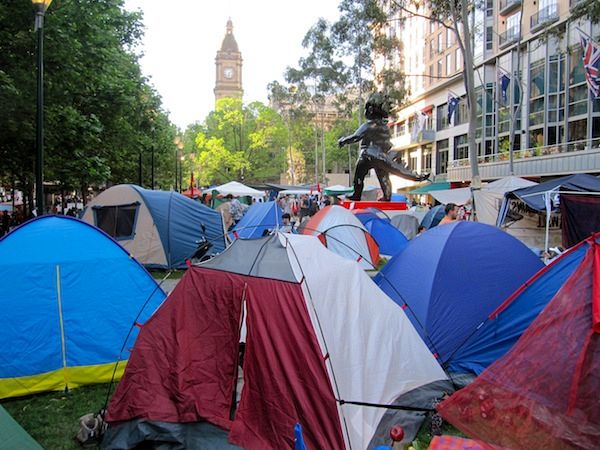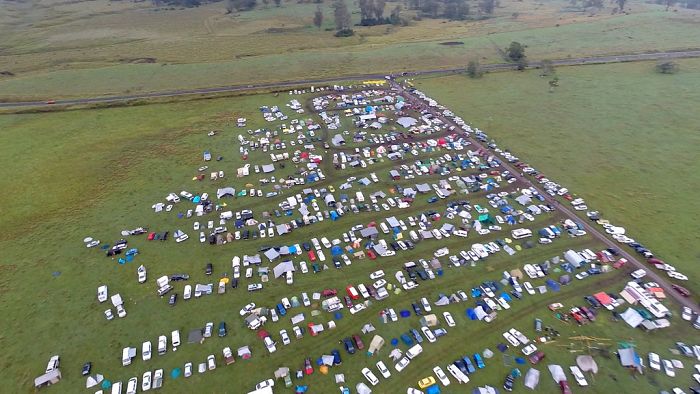Australia — no home for the homeless
Hungry and homeless
Abbott's first Budget will only add to the problem of
homelessness. How to house all these people? Perhaps we can learn from
Occupy, writes social commentator, Dr Matthew Mitchell.
IMAGINE THAT YOU HAD A PLACE to call home.
A place to which you had an undeniable birth right. A place to which –
no matter where you roamed – you could always return and be welcome. A
place where familiar faces would always greet you with open arms.
Imagine then that this place also provided – with a little effort –
all your food and other needs. Imagine also, that this place was a
garden paradise, cultivated by your family for generations — a
cultivation to which you also could contribute.
Imagine that this is then suddenly all taken away. The friendly faces
of living and caring friends and family are replaced by the cold faces
of a desperate, greedy and violent people. You, and your community, are
forcibly removed. Abused and killed in the process.
Over the ensuing years you watch as, midst much ugly dispute, the
garden paradise is divided up and transformed. In some places the
transformation is slow; in others it is rapid and dramatic. The
landscape is dug up, aided by machines that belch filth and which leave enormous permanent scars.
The land that was once a mother to you and your people is changed
forever. The society which nurtured you and people permanently changed —
if not extinguished.
Based on the accounts of Bill Gammage and available historical records, this is the crime European settlers have perpetrated on the Australian landscape and on its Indigenous people.
Gammage’s fundamental point was the ‘sophisticated, successful and sensitive farming regime integrated across the Australian landmass’
– described by him as ‘a majestic achievement’ – ended with European
settlement. And it is this crime that is, perhaps, still denied by
many.
Not only was it a crime, but it hints at the errors of our society.
Australians now are not born with a home as an undeniable birth right.
They do not inherit the security and comfort of knowing that, come
what may, there will always be a place where they are welcomed. Instead
they are born dispossessed. Born into a country which has been neatly
parcelled out to private owners.
A home for most Australians now is something insecure, something that
takes many a lifetime to attain, and for some is never attained.
Something that can coldly and callously be taken away when one is most
vulnerable, due perhaps to the loss of a job or an inability to work due
to personal injury or distress.
Banks can repossess if payments are not made — and even if this never
happens, all those with a mortgage must live under the oppressive
anxiety of this threat.
And even once a home is owned it is not safe. If one struggles to pay council rates, the home can be forfeited.

Again the essential trait of our society comes forth. Just when one
is most vulnerable, our society allows them to be kicked while down.
Once homeless, for tens of thousands of Australians, there is nowhere to
go.
‘Authorities’ do not tolerate them on the streets, or in the parks. Even if they manage to live in these places they are subject to violence and sexual abuse.
How Australia has changed since European settlement! How it has progressed!
And now we find it is not just Australia, but the same pattern is occurring across the world. The masses are dispossessed whilst a small elite gain wealth and power, in the end corrupting the very institutions intended to check their power.
The Ancien Régime, the aristocracy, is re-establishing itself. We
return to an age whereby common people are serfs – people without
rights, who live in constant insecurity, slaves to their masters who
possess everything, if not the people themselves.
Once again ‘commoners’ must begin the fight for basic human rights. These are the right to trial, for protection against arbitrary imprisonment and rights
which have been stripped back under the protection against arbitrary
imprisonment. The rights stripped back under the guise of anti-terrorist
laws, along with mass surveillance, turn out really to be a means of
protecting the privileges of the elite against even non-violent protest (even conservatives are worried about this).
Then, if a people like the Crimeans find themselves as pawns caught between two covetous global powers – both of which seek only to exploit both people and resources
– and have to choose one side over the other in a legitimate
referendum, propaganda machines are invoked, one power accusing the
other.
This is the society we now live in. This is modern Australia, as it is the modern world.
And it is not the first time we have been here. Writing during an
earlier time of inequality (if it in fact is distinct from the processes
active now) Rousseau declared:
“The first man who, having fenced in a piece of land, said "This
is mine," and found people naïve enough to believe him, that man was
the true founder of civil society.
From how many crimes, wars, and murders, from how many horrors and
misfortunes might not any one have saved mankind, by pulling up the
stakes, or filling up the ditch, and crying to his fellows: Beware of
listening to this impostor; you are undone if you once forget that the
fruits of the earth belong to us all, and the earth itself to nobody.”
Whilst many aspects of his 1754 Discourse on Inequality may be questioned, perhaps there is some truth to the statement above?
Is there a solution?
So what can be done? At very least we should allow the most
dispossessed, the homeless, to be visible and to protect themselves as
best they can.
This can be easily done by allowing homeless people legitimate access
to public land to erect tents or swags, and communities of tents,
should they so choose. Thus protected from discrimination by
‘authorities’ they may be able to establish protective relationships
between themselves.
It is quite possible, likely even, that tent cities – perhaps even
slums - may arise, but this itself is necessary if we are to make the
problems of homelessness visible to people and government. Such
visibility might be the first step towards better solutions.
Would such communities be an improvement? I believe they would be. The Occupy tent
encampment in Melbourne was just such a ‘tent’ city. And it was
occupied by at least some genuine homeless, and many marginalised in
other ways.

Occupy's tent city, October 2011, Melbourne (courtesy Graham Miln)
The Occupy community was highly organised. It was kept clean and
elections were held for organisers in the community so as to ensure
pathways were kept clear.
Others participated in 24 hour ‘security’ patrols (in shifts) around
the perimeter. This was necessary because the biggest problems arose not
within the camp, but from everyday people passing by who would
occasionally try and thump a few of the occupiers.
The response of occupiers to the one incident of internal violence I
witnessed in the camp has led me to believe that evictions can be dealt
with non-violently simply by a crowd of people standing around the
perpetrator and shouting “shame” repeatedly until he or she leaves.
Coal seam gas protestors in Australia’s Northern Rivers region were
recently living in a large tent camp (on a private property) quite
happily and comfortably. Why cannot our poor be able to do this?

Bentley Blockade camp, NSW
It is entirely possible that living in a tent city may actually offer
the homeless better and safer conditions than in built accommodation
especially given accusations that the homeless are being exploited by unscrupulous landlords.
In any case, tent encampments are not unprecedented in Australia. They were certainly common during the 1929 Great Depression. In fact, in early days, most Australian cities and towns were tent cities.
And apart from reducing vulnerability, legitimate homeless camps may
also offer many other benefits in relation to delivering needed services
and other assistance.
If allowed, homeless camps would not be unique to Australia as a developed nation.
As many early immigrants to Australia were haunted by the squalor of
cramped London living, most Australian cities were designed with vast
parkland areas. These offer more than enough space to accommodate our
homeless whilst not excluding other uses.
The only barrier seems to be the sensibilities of the modern gentry and local authorities.

This work is licensed under a Creative Commons Attribution-NonCommercial-NoDerivs 3.0 Australia License





No comments:
Post a Comment